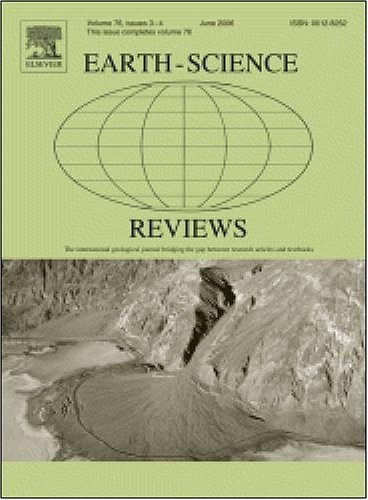The deep conductive layer in the Icelandic crust
IF 10
1区 地球科学
Q1 GEOSCIENCES, MULTIDISCIPLINARY
引用次数: 0
Abstract
Early MagnetoTelluric (MT) resistivity soundings in Iceland revealed a Deep Conductive Layer (DCL), a layer with anomalously high conductivity, at the depth of 5-20 km (upper seismic layer 3) in the crust under most of the country. When first observed in the 1970s, the DCL was interpreted as partial melt below a thin and hot crust. Later seismic and gravity studies have showed that the crust is 20–40 km thick, dense and relatively cold. The DCL is thus an intra-crustal layer below the brittle/ductile transition and does not correlate with any currently known seismic feature. In this paper we try to narrow down the possible origin(s) and nature of the enigmatic DCL and how its presence can be understood in the framework of the thick and cold crustal model. We review existing electrical conductivity data from early MT measurements done in the 1970s and 1980s and from recent surveys mostly done in the context of geothermal exploration. The DCL domes up beneath active central volcanoes and high temperature geothermal areas. It is found to be electrically anisotropic, being more conductive in the spreading direction than in the tectonic/fracture direction. We review several possible conduction mechanisms that could explain the high conductivity in the light of recent experimental work on electrical conductivity of minerals and rocks and discuss the possible prevailing conduction mechanisms in the light of existing geophysical and petrological observations in Iceland. These investigations show that seismic and electrical surveys are both compatible with the presence of melt in the DCL in the volcanic plumbing system associated to volcanoes. Outside active volcanoes, seismic properties of the DCL, inferred from local tomography, are not compatible with the presence of melt or even aqueous fluid in the DCL but confirm thick, cold and fluid-free lower crust, leaving only solid-state conduction as a viable conduction mechanism. Review of laboratory measurements on various type of minerals leads to the conclusion that the presence of Fe![]() Ti oxides or hydrated minerals, such as amphibole, could explain the DCL. In Eyjafjörður, North Iceland, the only low-temperature geothermal area studied using MT to date, the DCL locally domes up to shallow depths under the geothermal area. This suggests possible correlation between low-temperature geothermal activity and relatively shallow DCL. Detailed mapping of the DCL might therefore be an important tool in prospection for low-temperature geothermal resources.
Ti oxides or hydrated minerals, such as amphibole, could explain the DCL. In Eyjafjörður, North Iceland, the only low-temperature geothermal area studied using MT to date, the DCL locally domes up to shallow depths under the geothermal area. This suggests possible correlation between low-temperature geothermal activity and relatively shallow DCL. Detailed mapping of the DCL might therefore be an important tool in prospection for low-temperature geothermal resources.
冰岛地壳深处的导电层
在冰岛的早期MT电阻率测深发现了一个深导电层(DCL),这是一个异常高导电性的层,深度为5-15 km(上地震层3),位于该国大部分地区的地壳中。在20世纪70年代首次观测到的时候,DCL被解释为薄而热的地壳下的部分融化。后来的地震和重力研究表明,地壳厚度为20-40,密度大,温度相对较低。因此,DCL是脆/韧性过渡之下的地壳内层,与目前已知的任何地震特征无关。在本文中,我们试图缩小可能的起源(s)和神秘的DCL的性质,以及如何在厚和冷的地壳模式的框架下理解它的存在。我们回顾了20世纪70年代和80年代早期大地电磁测量的现有电导率数据,以及最近主要在地热勘探背景下进行的调查。DCL在具有高温地热区的中央火山之下呈圆顶状。发现它具有电各向异性,在扩展方向比构造/断裂方向更导电。我们回顾了几种可能的传导机制,这些机制可以解释最近关于矿物和岩石电导率的实验工作,并根据冰岛现有的地球物理和岩石学观测讨论了可能的普遍传导机制。这些研究表明,地震和电测量都与与火山有关的火山管道系统中DCL中熔体的存在相一致。在活火山之外,从局部层析成像推断出的DCL的地震特性与DCL中存在熔体甚至含水流体不相容,但证实了厚、冷和无流体的下地壳,只留下固态传导作为可行的传导机制。对各种矿物的实验室测量结果的回顾得出结论,铁钛氧化物或水合矿物,如角闪洞,可以解释DCL。在冰岛北部Eyjafjörður,迄今为止唯一使用MT进行研究的低温地区,DCL局部呈圆顶状,一直延伸到地热区下方的浅层。这表明低温地热活动可能与相对较浅的DCL有关。因此,DCL的详细制图可能是勘探低温地热资源的重要工具。
本文章由计算机程序翻译,如有差异,请以英文原文为准。
求助全文
约1分钟内获得全文
求助全文
来源期刊

Earth-Science Reviews
地学-地球科学综合
CiteScore
21.70
自引率
5.80%
发文量
294
审稿时长
15.1 weeks
期刊介绍:
Covering a much wider field than the usual specialist journals, Earth Science Reviews publishes review articles dealing with all aspects of Earth Sciences, and is an important vehicle for allowing readers to see their particular interest related to the Earth Sciences as a whole.
 求助内容:
求助内容: 应助结果提醒方式:
应助结果提醒方式:


